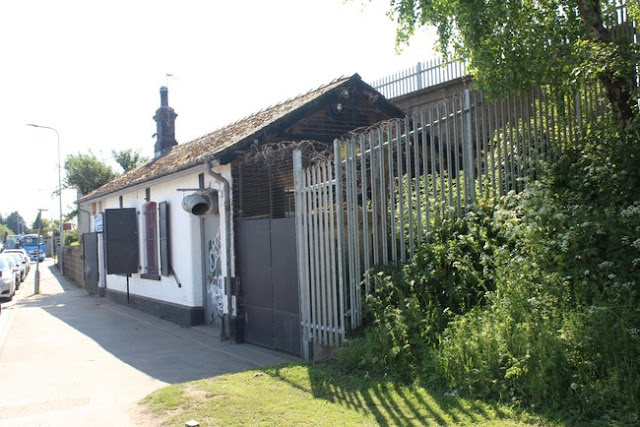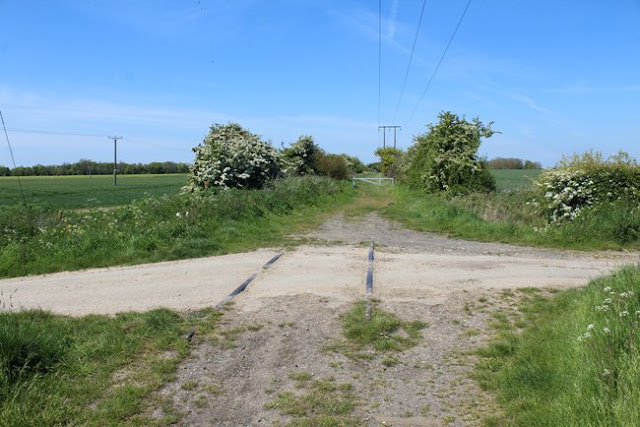Starting Point - Duesbury Street, Hull. Finishing Point - Former Hornsea Station. Distance - 14.6 Miles
Opened in 1864 the route connected the coastal town of Hornsea to Hull's Victoria Dock Branch, the line saw just over a century of use before closing as part of the Beeching cuts of the 1960s. Today the line is part of the Trans Pennine Trail cycle route and some of the remnants of the railway survive remarkably well. I cycled out and back along the former route, though at 14.6 miles and with regular East Yorkshire buses back from Hornsea it would also work as a day's walk.
The Victoria Dock Branch connected to the lines in to Hull's main Paragon station at West Parade Junction and a stub of the line gives access to the Botanic Gardens depot where trains are maintained for Northern services centred on Hull. Growing up in Hull I can recall when Botanic Gardens was a much bigger depot and the lines continued up to Spring Bank and diesel units could be seen. The depot was downsized in the late 1980s though and the area to the south of Spring Bank is now the Jacksons Bakery.
North of the level crossing on Spring Bank was Botanic Gardens station. Previously named Cemetary Gates it was renamed, some say as elderley passengers never wanted to ask for a ticket to Cemetary Gates. The site of the station is now occupied by the Old Zoological pub. A bit of retaining wall can also be seen at the back of the Jet petrol station.
Below - Botanic Gardens station in 1967, closed to passengers at this time but still retained for Victoria Dock branch freight until the following year. (By Ben Brooksbank, CC BY-SA 2.0, https://commons.wikimedia.org/w/index.php?curid=10436210)
The cycle route can be picked up at the end of Duesbery Street and soon brings us to Hull's next surburban station on the Victoria Docks branch, Stepney. The main building and platforms of Stepney station are intact.
The Victoria Dock Branch was notorious for having several level crossings, including on the busy Spring Bank and Beverley Road here at Stepney. When the Hornsea and Withernsea routes were closed connections were made in the east of the city to the Hull and Barnsley Railway's line to Alexander and King George Docks, a high level route that crossed the city on embankments and bridges.
As the former Victoria Dock branch passes over the Beverley and Barmston Drain on a bridge the Hull and Barnsley Railway's line in to its Cannon Street station crossed over on a bridge to the west of the drain. The bridge was removed but the remains of the embankments can be seen and a footpath follows the former line.
After crossing the drain the former Sculcoates Goods Shed can be seen on the left. Also referred to as Stepney or Wilmington Goods Shed it was close to the River Hull and in quite an industrialised area so quite a large goods shed. It is a listed building and survives in industrial use.
The line crossed the river on a swing bridge, the bridge also had a footpath on one side of the bridge. The path resulted in the survival of the bridge and required that even after the railway closed the bridge had to be manned to open it for river traffic. During a refurbishment in the 80s or 90s the footpath was moved on to the main span of the bridge. Today there is little river traffic and it is probably a long time since the bridge has had to operate, though the cabin survives on the top of the bridge which is a listed structure.
Below - Wilmington Swing Bridge
On the left is the former British Extracting Co mill which had a connection to the former Hull and Barnsley Railway.

After crossing the river the next station was Wilmington, this served as a junction with the Withernsea line. It had a small station building on Foster St and a subway to access the wooden island platform. The station building survives as a cafe and the entrance to the subway can be seen at the back of it, though the station site has been redeveloped for industrial use.
Due to industrial redevelopment a detour is required to pick up the path at the end of Montrose street where the former Hull and Barnsley Railway route crossed over the Hornsea line and Foredyke Stream.
After Chamberlain Road a path curves off to the left at what was Stoneferry Junction, this was a short branch line to serve the Stoneferry Goods Shed and the riverside Premier Oil Extracting Mills and Earles Cement.
As the former line passed under Church Street we reach the next station, Sutton. What would be a Hull suburban station if it were here today this was once more a village near Hull and when the line ran through the area the old maps show the line passing through little more than fields.
Below - Bridge at the site of Sutton station under restoration.
The next station was Swine, again a quite rural location it was situated where the line crossed Coniston Lane. The road would have been used to serve farms in the surrounding area and a coal depot was provided in the small goods yard so provisions could have been collected by cart as there was little development around the station itself.
Below - Former Swine Station
Below - Old coal drops at Swine station
Next stop is Skirlaugh station where the line crossed Oubrough lane, now the A165. Again there was little here but a small goods yard with coal drops were provided for the rural communities in the area. A car park for the Trans Pennine Trail is now provided at the former goods yard entrance for those wishing to drive here to explore part of the trail on foot or bike.
Below - Platform of former Skirlaugh Station
The first Ellerby station was another rural stop that only warrented a train on Tuesdays for market day. It closed in 1902 and the station building became known as Ellerby Gatehouse as it still housed the keeper for the crossing on Skirlaugh Road. On the north side of the road a single siding was provided, known as Ellerby siding when the station was closed. The station building survives though it has been extended in all directions, the extensions follow the character of the original building but this gives the impression that it was a much grander station.
Below - The original Ellerby station
Where the line crossed in a cutting under Lambwath Lane was the station of Burton Constable. A more substantial affair, this served the communities of Marton, Burton Constable and Ellerby when its own station closed. At various times the station carried the name of all three communities. The North Eastern Railway having other stations named Marton and Constable Burton it was felt these names would cause confusion. Today the path has been banked up to meet the road and the former station building survives as a private residence now screened from view from the former railway line by trees.
One of the best preserved stations on the route is Whitedale, another very rural stop with a simple goods yard and coal drops.
Below - Former Whitedale station
Below - Former coal drops at Whitedale
The next stop Sigglesthorne was between the villages of Little Hatfield and Great Hatfield after which it was named Hatfield until 1874 when it was renamed to avoid confusion with another Hatfield, a recurring theme on the route. Situated at the level crossing with Sigglesthorne Road, the platforms were staggered either side of the road and can still be seen, remarkably with the original wooden fences still largely intact.
Below - Former Sigglesthorne station.
The next stop was Wassand, previously Goxhill. Another rural stop that had a market days only service, this was closed to passengers in 1953 and goods in 1960 before the Beeching report saw the closure of the route itself.
Below - Former Wassand station
The next stop was Hornsea Bridge. Originally intended as the terminus of the line however it was decided to push on to the seafront despite the considerable increase in cost this entailed. Hornsea bridge had wooden platforms on an embankment where the railway crossed Rolston Road on a bridge. With the road subsequently widened, becoming the B1242, the bridge has been removed and the site of the station and goods yard redeveloped. Hornsea Bridge's goods yard served as the main goods facility for Hornsea itself.
A short walk from the sea front, Hornsea's main station was quite a grand building which survives to this day, though converted to houses. Though little changed on the frontage a couple of outbuidings were added on the former platform 3 side where there used to be a roof covering the platform and railway. Station Court was built on the site of platforms 1 and 2 that were effectively excursion platforms and lacked canopies or buildings but would generally only have seen use in the summer holidays. Adjoining the station the former station master's house survives and across the road the former Alexandra Hotel built to serve the station.
Below - Former Hornsea station
Below - Former station master's house at Hornsea.































































